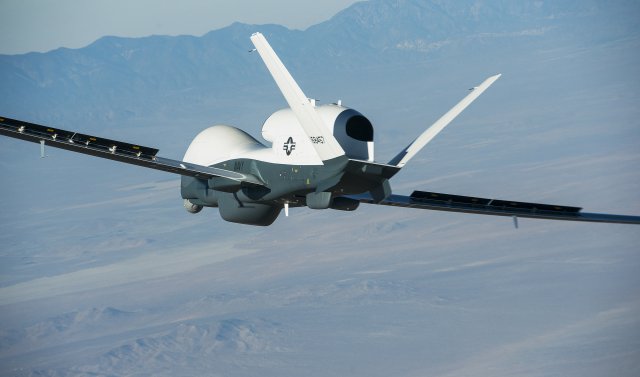 The Navy’s newest unmanned Intelligence, Surveillance and Reconnaissance (ISR) aircraft platform, the MQ-4C Triton Unmanned Aircraft System (UAS), completed its first flight from Palmdale, California on May 22, marking the start of tests which will validate the Northrop Grumman-built system for future fleet operations.
The Navy’s newest unmanned Intelligence, Surveillance and Reconnaissance (ISR) aircraft platform, the MQ-4C Triton Unmanned Aircraft System (UAS), completed its first flight from Palmdale, California on May 22, marking the start of tests which will validate the Northrop Grumman-built system for future fleet operations.
During the 80-minute flight in restricted airspace, the MQ-4C Triton unmanned aircraft, controlled by ground-based Navy and Northrop Grumman personnel, reached 20,000 feet altitude.
“This flight represents a significant milestone for the Triton team,” said Rear Admiral Mat Winter, who leads the Program Executive Office for Unmanned Aviation and Strike Weapons at Naval Air Systems Command, Patuxent River, Md. “The work they have done and will continue to do is critical to the future of naval aviation, particularly to our maritime patrol and reconnaissance community.”
The MQ-4C Triton provides the fleet with a game-changing persistent maritime and littoral ISR data collection and dissemination capability, said Winter. It will be a key component of the Navy’s Maritime Patrol and Reconnaissance Force family of systems.
As an adjunct to the manned P-8A Poseidon, the MQ-4C Triton will be a major part of the military’s surveillance strategy for the Asia and Pacific regions. The Triton will fly missions for 24 hours at altitudes greater than 10 miles, allowing the system to monitor 2,000 nautical miles of ocean and littoral areas at a time.
The P-8A Poseidon is the Navy’s new multi-mission maritime aircraft being built to replace the P-3C Orion long-range anti-submarine warfare aircraft.
“When operational, the MQ-4C will complement our manned P-8 because it can fly for long periods, transmit its information in real-time to units in the air and on ground, as well as use less resources than previous surveillance aircraft,” said Rear Adm. Sean Buck, Patrol and Reconnaissance Group commander, who also witnessed today’s flight. “Triton will bring an unprecedented ISR capability to the warfighter.”
The MQ-4C Triton UAS will be based at five locations around the globe. Triton operators will disseminate data in real-time to fleet units to support surface warfare, intelligence operations, strike warfare and search and rescue
“Our goal is to mature the Triton UAS before supporting the Navy’s maritime ISR mission,” said Captain Jim Hoke, Programme Manager for the Persistent Maritime UAS office (PMA-262), which oversees the Triton programme. “The data we collect the next few years is essential to certify the system for operational use. First flight represents a critical step in maturing Triton’s systems before operationally supporting the Navy’s maritime surveillance mission around the world. Replacing our aging surveillance aircraft with a system like Triton will allow us to monitor ocean areas significantly larger with greater persistence.”
Flight tests will continue in California for the next several months before the team transitions the aircraft to Patuxent River in the fall.
Triton is specially designed to fly surveillance missions up to 24 hours at altitudes of more than 10 miles – allowing coverage out to 2,000 nautical miles. The advanced suite of sensors can detect and automatically classify different types of ships.
“Triton is the most advanced intelligence, surveillance and reconnaissance [ISR] unmanned aircraft system ever designed for use across vast ocean areas and coastal regions,” said Mike Mackey, Northrop Grumman Triton UAS Deputy Programme Director. “Through a cooperative effort with the Navy and our industry partners, we successfully demonstrated the flight control systems that allow Triton to operate autonomously. We couldn’t be prouder of the entire team for this achievement.”
In 2008, Northrop Grumman was awarded a systems development and demonstration contract to build two aircraft and test them in preparation for operational missions.
The Navy’s programme of record calls for 68 Tritons to be built.
Triton carries a variety of ISR sensor payloads that allow military commanders to gather high-resolution imagery, use radar to detect targets, and provide airborne communications and information sharing capabilities to military units across long distances.
At 130.9 feet, Triton has a wingspan larger than the world’s most common commercial airliner, the Boeing 737. Combined with an efficient engine and other aerodynamic design features, Triton can fly 11,500 miles without refueling.
Northrop Grumman’s Triton industry team includes Aurora Flight Sciences, BAE Systems, Curtis-Wright Corporation, L3 Communications, Raytheon, Rolls-Royce, Sierra Nevada Corporation and Vought Aircraft Industries.
Source: Press Release
